Launched From a Copy Machine in San Antonio
- 9 July 2018
- ByNilina Mason-Campbell
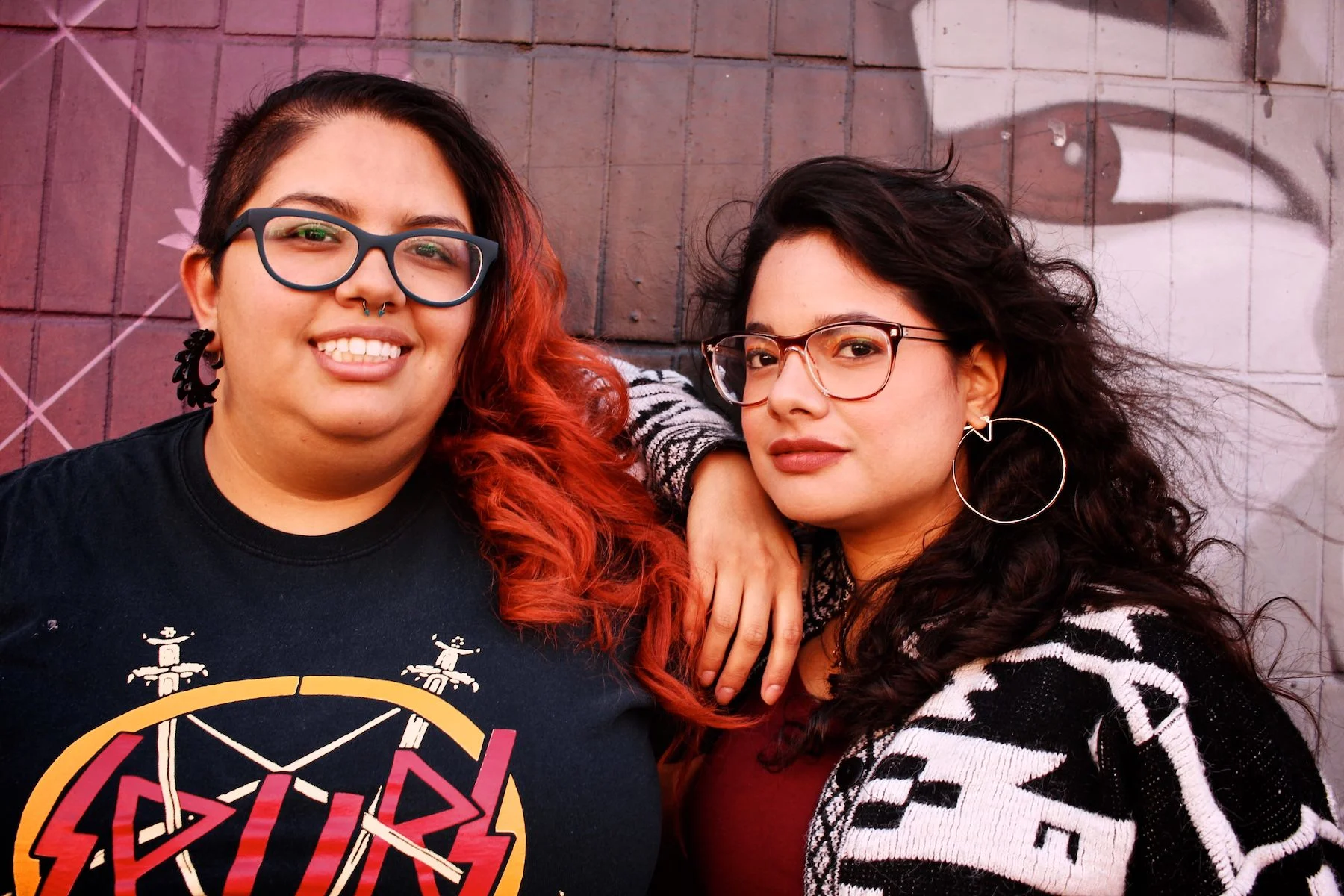
Sometimes all you need is a name.
St. Sucia began as an idea for a made-up patron saint and has since morphed into a intersectional zine and an empire of opportunity. Founded by Isabel Ann Castro and Natasha I Hernandez, the three-times-a-year periodical aims to speak for and to the modern mujer, the Spanish word for woman. A seemingly niche publishing category has given much needed space to what in reality is a large, diverse global community. Tackling Latina feminism on a spectrum far and wide, the inclusive zine showcases a kaleidoscope of experiences, beyond borders and the binary.
Launched from a copy machine in San Antonio, Texas, St. Sucia now has a large presence outside of the Lone Star state thanks to distribution in book stores and shops from coast to coast. The pair regularly travel to out-of-state zinefests, and copies of the periodical can be found online via their Big Cartel shop too. And those aren’t the only channels. St. Sucia is now taught as part of university syllabuses and archived on campuses across the nation including University of Santa Barbara, Northwestern University, Duke University, and UC Davis. San Antonio still remains the zine’s home base - a city that plays as much a role in the duo’s writing as it does in their own identity.
We caught up with Castro and Hernandez to talk about their rise within the zine-sphere, both in terms of success and their ever growing audience. As DIY binding sessions have given way to professional print-runs in the thousands, curating public readings, and lecturing to undergrads, the pair has continued their mission to give a voice to the underrepresented. With that in mind, we also talked about creating space and the importance of visibility.
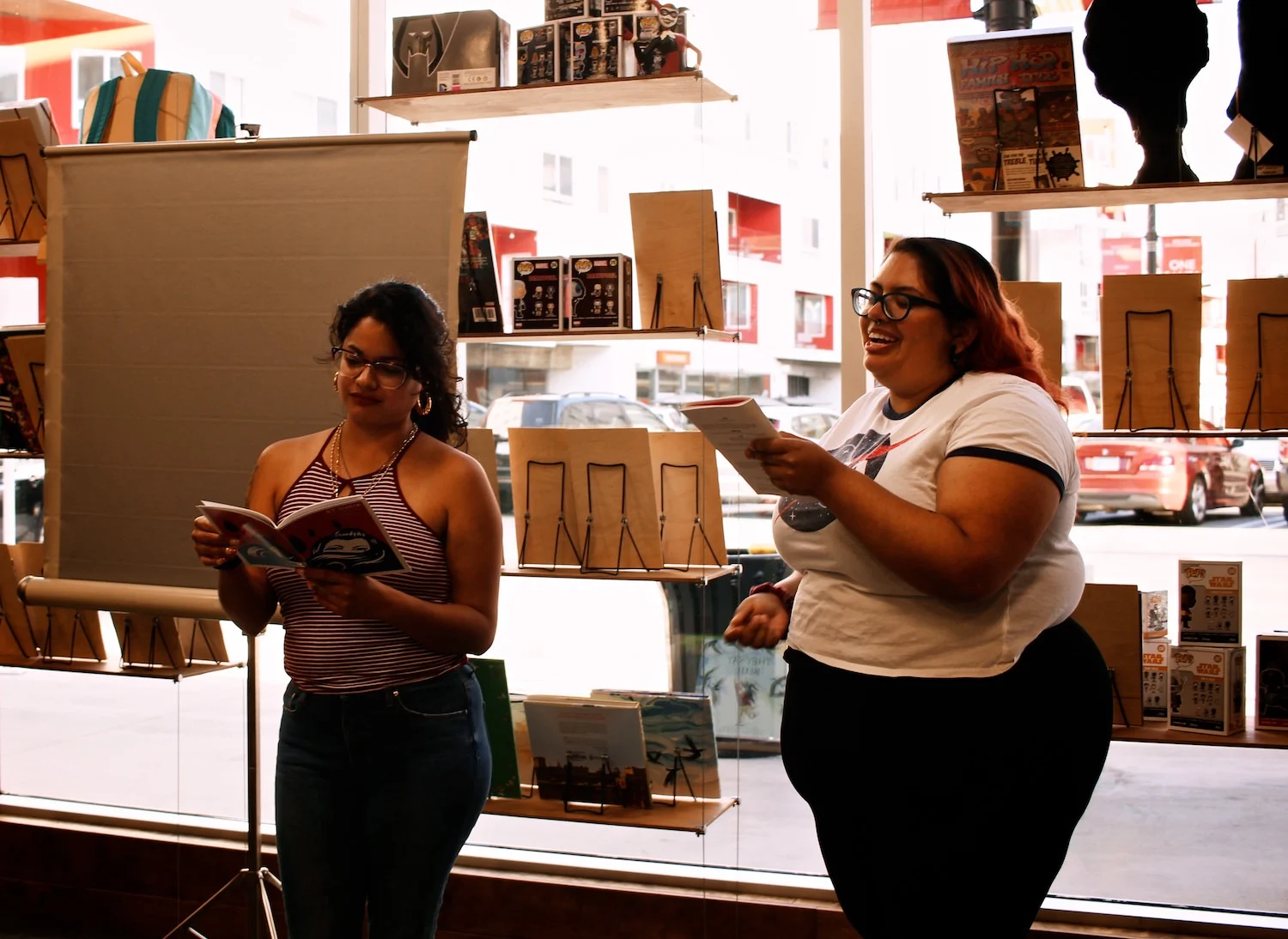
Photography by Nilina Mason Campbell
How did the zine first come together?
Natasha: The zine started in December 2014. Our ex-boyfriends were in the same punk band, that’s how we met each other. Isa and her friends in college made St. Sucia, a fake saint. Instead of talking to Virgin de Guadalupe, you ask a different saint because you’re embarrassed to ask the Virgin to help your Plan B work, stuff like that. Isa had this idea for St. Sucia and we were both at a show at this bar called High Tones. I was outside smoking a cigarette and she came up to me and asked if I wanted to do a zine where brown girls get real and just talk shit.
I said ‘Sure, why not!’
The first issue, Isa was coming off of some issues with a previous relationship. I totally understood, I had the same issues with my previous relationship - I was in an abusive relationship. I had so much written about that, and the idea was just to be real, open it up, say what we want to say. The first issue was really fun and sex-positive, had jokes about one night stands, and a piece I wrote to make it look like a fake magazine. But it was real stories - like this is my abortion story, or this poem is about some trauma I went through.
After we released the first issue, all the submissions we were getting from strangers were super heavy: identity, culture, language. Serious topics. We were like, OK, we need to get them printed somewhere to make them look decent, so that you can actually read them. Let’s just respect this work and see what happens. It was a thing where it was like, we’ll just do one more, we’ll just do one more, and it became 11 issues. Somewhere in there we became international. Somewhere in there we started getting distribution to bookstores around the country.
What was that process like?
Isabelle: Sometimes it’s just us traveling. We went to San Francisco Zinefest - in our free time we’d go to bookstores there and be like, ‘Hey this is what we have, a backpack full of zines.’ We’d just ask if they wanted to carry it, and they would.
Natasha: Or sometimes people message us. It’s all been us approaching people or word of mouth. Just like, this is what we do, do you want to look at it, how do you feel about this - that’s it.
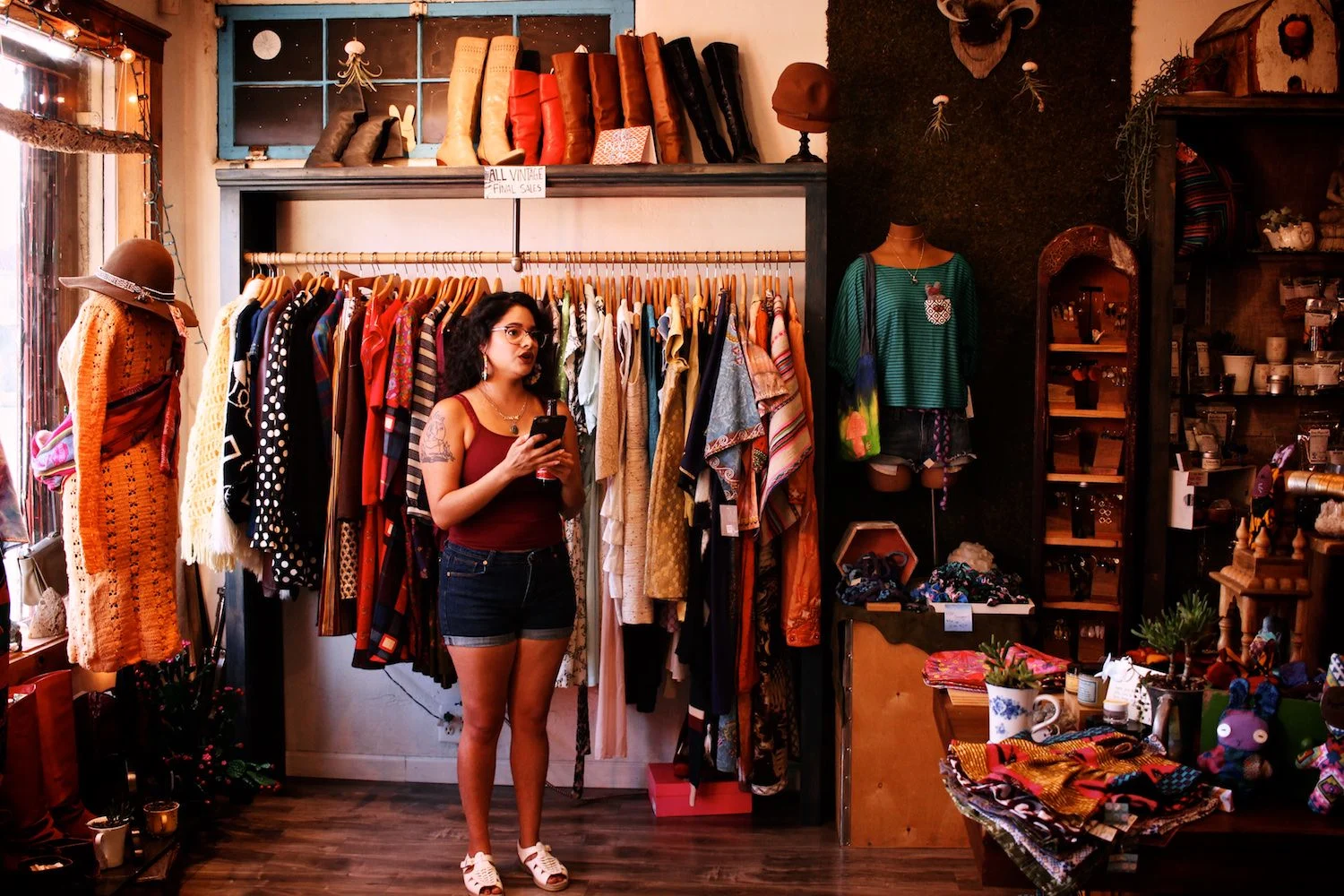
What have been some of the bigger opportunities linked to the zine?
Natasha: We got added to the syllabus in a few programs for Gender Studies, Latino Studies, and Chicano Studies. The first time we got added to a syllabus we only had three or four issues. It was at University of Santa Barbara. Somebody from Texas was a professor over there and wanted to add contemporary literature to the syllabus. She went to one of our zine releases randomly, saw the zine, and added it to her syllabus. She then brought us in to guest lecture. After that we got picked up by other universities, including Northwestern.
Isabelle: We did a Skype guest lecture with them. That was really cool.
Natasha: Yeah, we lectured twice at UTSA, we lectured at Texas A&M, and we’ve been added to archives. A bunch of different universities just started randomly ordering from us.
Isabelle: UC Davis just added us. Bought the entire set, which is really awesome!
Natasha: And then we tell people that and they’re like, ‘I’m not really a writer or artist, but I submitted, and thanks for publishing that comic I drew about buying birth control pills.’ And we’re like, ‘You’re archived in a university now.’
A lot of times people don’t feel they’re writers or artists because of their day job. I’m the same way; it took me a whole year of us doing the zine for me to even tell people I write. I was writing under a fake name for the first few issues. I would write the editor’s statement, edit everything, and then write under a fake name.
I had to look in the mirror and realize I was telling women to believe in themselves, they could do it, that we wanted to publish them, they were a writer because they write. And I couldn’t look in the mirror and do that for myself. I would tell myself ‘You’re a nurse. You work in hospital. You’re a nurse and that’s all that you are, quit thinking you’re a writer, you’re not a published writer.’ And then it was like, ‘You’re crazy! You’re published! You’re in a university!’
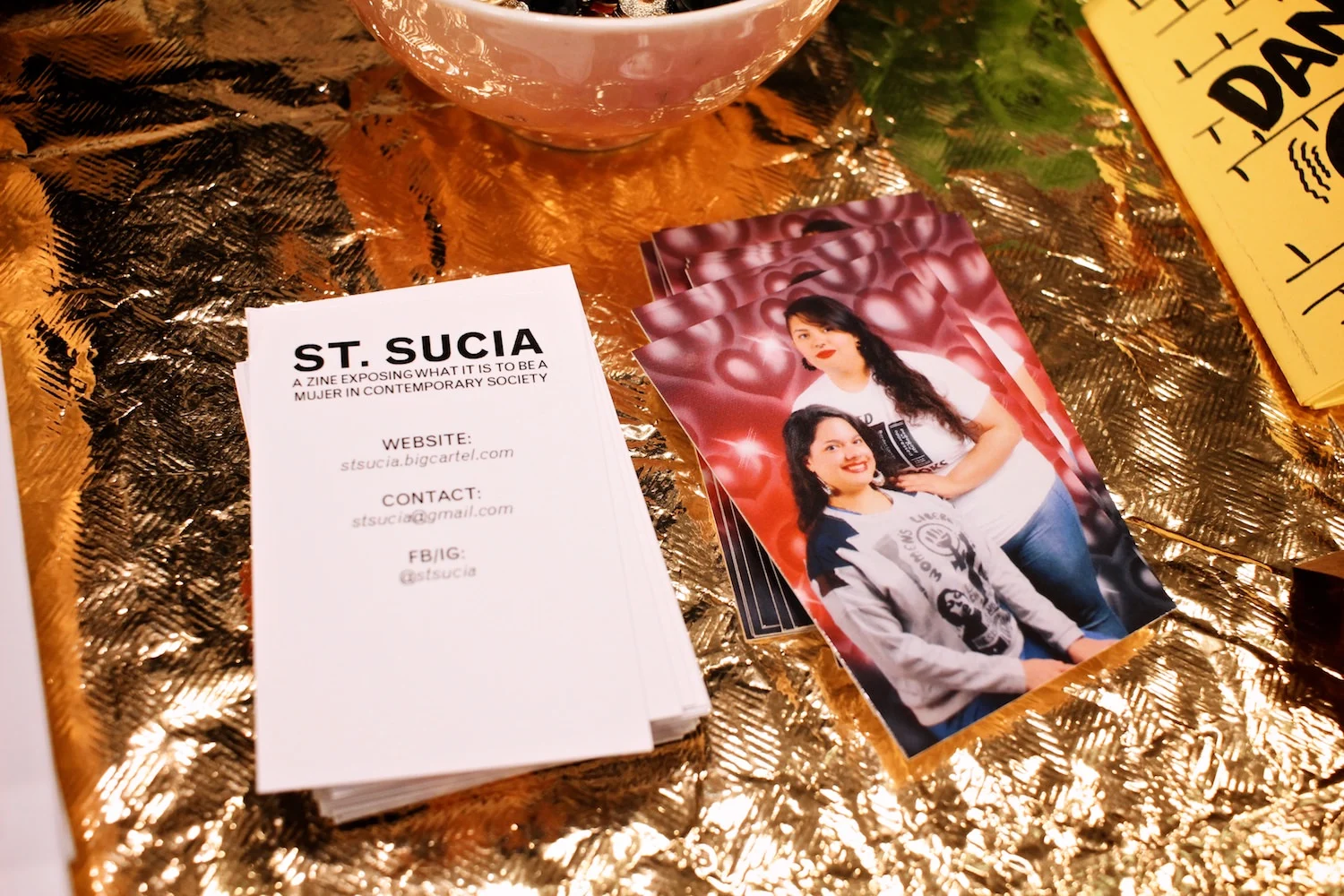
Speaking of day jobs, how much time does this project absorb?
Isabelle: We don’t make any money off the zine. We just put it together after hours. When we started I was working for the county in San Antonio and she was a nurse at the hospital. I’d show up at her house when she got off of work, and she’d be in scrubs. We’d be like, ‘Let’s go!’ And she would say she needs to go to bed at one to wake up at six to go to the hospital. So we’d have a couple of hours where we’d try to knock out as much as we could.
Now you give yourself more time to digest and edit the heavier topics. Do you think your personal story has assisted you with tackling those harder subjects now that you’re getting them as submissions as well?
Natasha: I think that since the beginning, we were going to be real and honest. And right off the bat it was serious stuff.
Also, a lot of things that are taboo for Latinas to talk about; for our first scene we had an illustration of a lady masturbating, and we were like, yes, awesome, that happens and that’s real, but it’s not something we talk about.
Isabelle: It’s not a discussion you have with your family.
Natasha: So from the beginning we were doing that. From the first issue we have a poem about queer Latina. It was right off the bat. We had an abortion story first issue. That gave everyone permission to send us all of their real stories and true stories, whatever they felt like they needed to send us. I feel like it has been helping everyone heal and helping everyone feel visible.

In regards to that visibility, to some extent it seems like a niche category you’re publishing in, yet in reality it’s not all. What are your thoughts on that? I don’t find there’s a lot of printed material speaking to the identity that you are. And yet, it’s a wide population.
Natasha: That’s something that is super important to us, since we started. If we were going to say it was a Latina zine, we had to know there were intersections to being a Latina, there are all different types of Latinas. I’m Chicana, Isa is Mexican-American, but that doesn’t mean this is a Mexican-American zine and we can just focus on that.
We recognized that it’s a huge community and nobody is talking about Latina feminism; nobody is focusing on our ideas and perspectives about what’s going on, what our stories are. But you’re right, it’s a huge group of people with so many people and intersections and overlap. We’re a huge group of people and it’s all about recognizing that we do have a huge amount of things in common, that we can understand each other, and that we need to support each other as a community to build that solidarity, nationally and internationally, because our issues are the same.
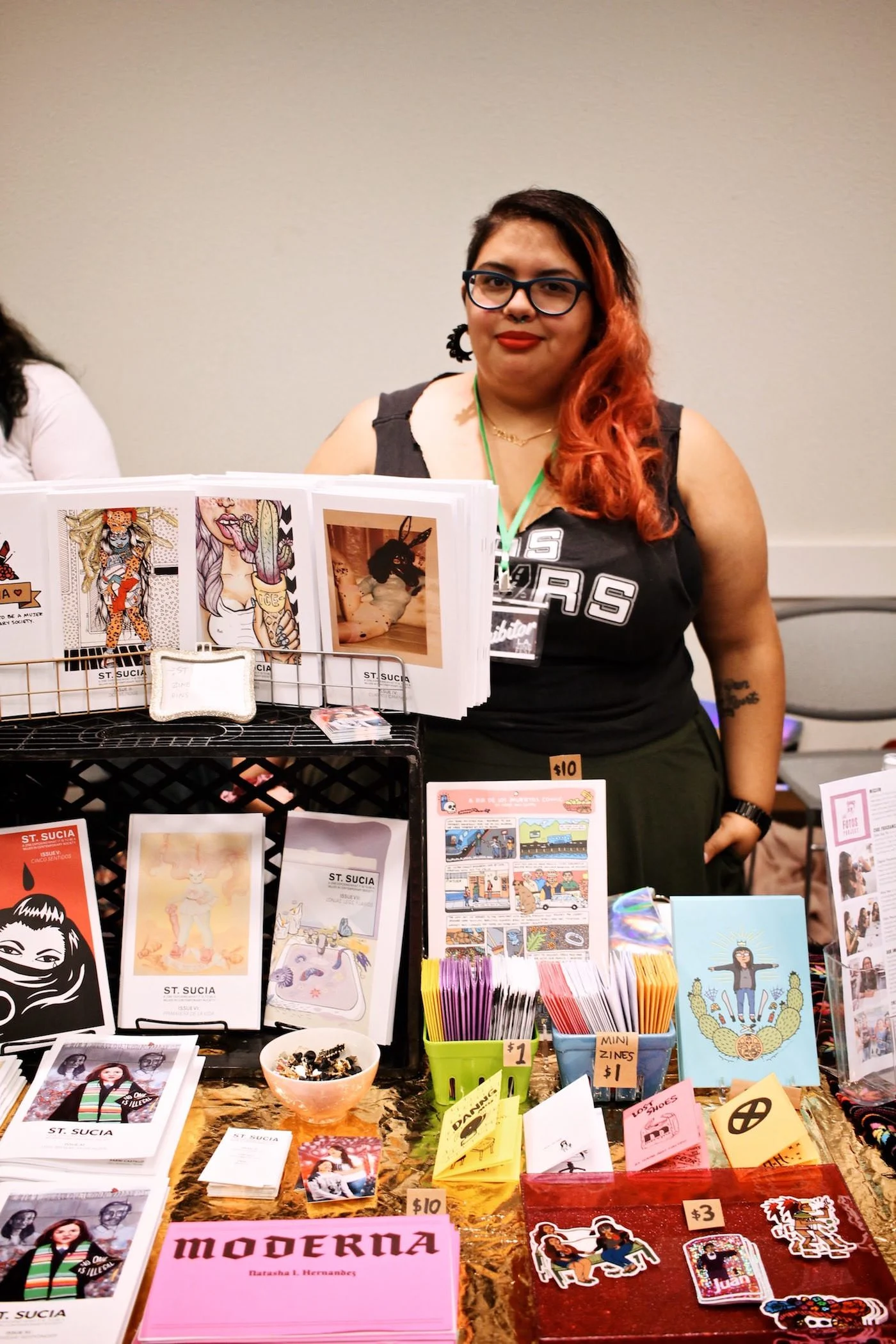
You use “mujer” and “mujeres” [the Spanish word for woman] instead of “Chicana” or “Latina.” Can you speak to the intention with that? When you use that, it speaks to Latina women, but people who know, know - that kind of thing.
Isabelle: Yeah, you have to know what the word means to identify. We’ve had someone print it who didn’t identify as “woman” but did as “mujer.”
Natasha: We’ve also published from gender non-conforming people. So yes it’s “mujer,” but it’s not necessarily one thing, just “chicana,” or anything like that. It was really organic. Isa and I didn’t have a conversation, like, ‘What is our identity title? How can we be inclusive?’ It was just something we thought was an easy “in” for everybody to see themselves.
San Antonio is prevalent in your work. How has the city shaped you, identity-wise, coming from there and being based there?
Natasha: I didn’t realize San Antonio was a brown city. As a little girl, as I grew up it was like “I’m a brown little girl, it’s normal for me to be a brown little girl, all my friends at school are brown, mayors are brown, cops are brown, teachers are brown... there’s all these places where I didn’t feel like an outsider because San Antonio is so brown. All of the Southside and Eastside is really black and brown. West San Antonio is very first and second generation from Mexico: you can go blocks and nothing is in English. North San Antonio is where there’s more white population - suburbs, that kind of stuff - where the Spurs live. But inside 410, San Antonio proper, is a super brown city.
Growing up there I never felt alienated; it felt normal and fine to be a minority. It was only as an adult, when I went outside of San Antonio, that I realized that I am an “other,” looked down on by some in the Midwest, by the South, by Europe, all these places. I realized that’s what people talked about when they talked about racism, sexism, all this stuff. But in San Antonio everyone looks like me on the Eastside, pretty much.

That's the power of living here - I’m from Portland and I’ve lived in Los Angeles for four years - being able to see brown Forest Rangers. I just had my back worked on; the guy was brown. It's been an epiphany. Portland is so white, and oh my goodness, this has been incredible. There is some real hard struggle here, but I’ll never get over what it has given me, to be able to see brown people in such a vast array of roles, because I had never seen it before.
Natasha: It’s super important. It’s super important to just see yourself represented in the community, to see things are possible. Brown doctors and nurses, that’s possible for me; teachers are brown, that’s possible for me. All these things that are super important for us to feel validated, like we can dream to be all these things. Growing up in San Antonio, it was like everything is fine, you’re normal. I didn’t feel that burden of being “less than.” Occasionally there were instances where I was in one part of town and people wouldn’t serve me or talk to me, or things like that. But I was like, ‘They’re just mean. Those people are mean and that’s their problem,’ because I was a kid.
San Antonio is just such a loud city. It’s so alive with culture and so alive with colors. It’s full of very unhealthy cheese-covered Mexican food, lots of partying and beer and loud music, dancing, lots of festivals in the streets. It’s just alive. Growing up there it just feels normal to be immersed in your culture and normal to be proud of your culture and to want to be anything you want to be, because you grow up seeing it all around you.
I love San Antonio. I mean, a lot of my poetry is talking shit. Critiques of fiesta, critiques of gentrification, or critiques of how people describe my part of town. That’s like, ‘Hey, I love you. We know better, let’s do better. Let’s talk about this so we can know better and do better for the city.’
Isabelle: I grew up on the Southside. Natasha is more inner-city, and I’m more rancho. I live center-bottom of San Antonio. I have three acres. We used to have boats and shit, chickens, it was dope. My mom was like, I don’t know, fifth-generation tejano, but my dad was from Mexico. So I’m working on how I identify, because I don’t identify as chicano. Closest I can get right now is just Mexican-American. Taking my dad to the doctor was a different experience than taking my mom. Being in that part of San Antonio was really great; there was a community that was definitely for my father and my mom, and my mom taught in the community.
It was very pleasant. I had a really good childhood. My culture was always around me. I didn’t really know how sweet it was until I went to Texas State where all my teachers were white and the work I was producing - suddenly I was in a whole different space where there were sororities and fraternities and it was just like the movies. I was like, ‘Oh my god, this is real?!’ It freaked me out. I couldn’t wait to get home. I’m going to graduate, and endure this - the micro-aggressions and straight-out racism on campus.
I think that experience shaped me to be better prepared to go home, to work in my community, and to do things that I felt mattered. That was the realization that I had been in a bubble - a brown bubble - and this is what people treat us like on the outside, and it’s not fucking cool, so we have to work to be unapologetic about all the shit we do. They don’t care until you’re important, and now what we do is starting to be [seen as] important. That’s when people turn heads and are either like, ‘Oh, you’re cool,” or, ‘Why are you here?’
We’re just trying to take up space. San Antonio for us has been the ultimate breeding ground for us to have these ideas and make them happen.
Natasha: There’s also a really good community right now of Latina female artists that are opening their own art galleries in like unused shopping centers–
Isabelle: Women of color just making shit happen in San Antonio.
9 July 2018
Words by:Nilina Mason-Campbell
- Share